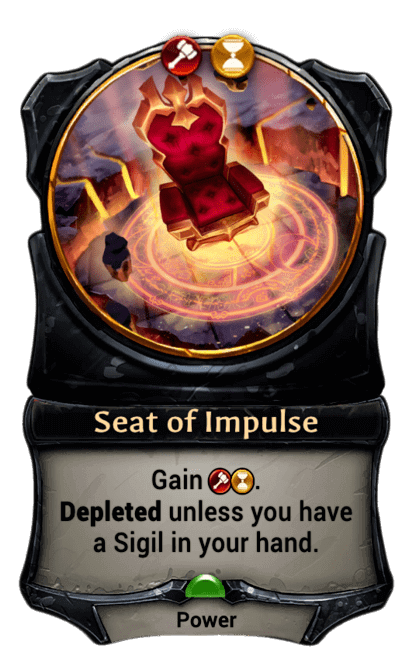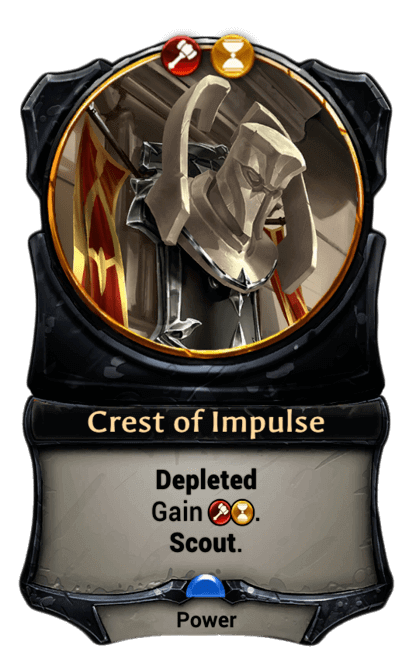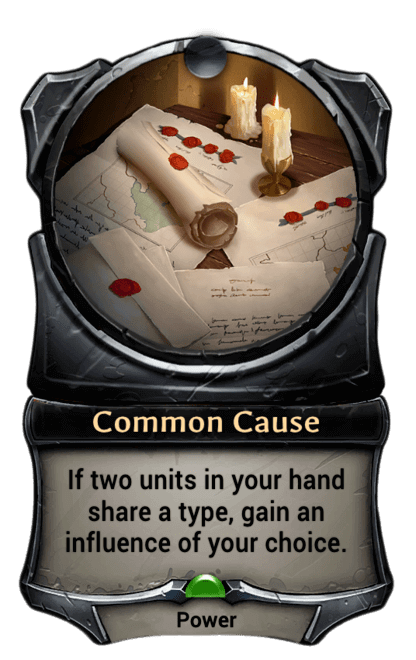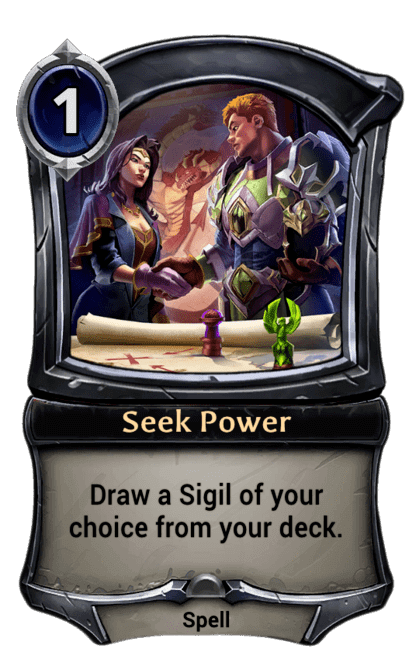

Sigils are power cards that work exactly like basic lands. There are also three cycles of dual power cards in all ten faction pairs, three cycles of mono-colored power cards, and a few unaffiliated power cards.
 The banners are common and simply ETBT unless you control a unit. These are great mid- and late-game, and are the only dual power cards you can expect to find in Draft (combined with a 45-card minimum, that format tends to be slow due to variance in getting the power you need).
The banners are common and simply ETBT unless you control a unit. These are great mid- and late-game, and are the only dual power cards you can expect to find in Draft (combined with a 45-card minimum, that format tends to be slow due to variance in getting the power you need).
The seats are uncommon and ETBT unless you have a sigil in hand. These tend to be better early but they're strength depends considerably on how many sigils you're running. Seats are the biggest reason to run Sigils over other power cards that ETB untapped.

The crests are rare, and exactly the same as the Temple of Triumph cycle, always ETBT and scrying 1. As good as the temples are in Magic, the crests are 5/4 as strong because there's even more variance to mitigate. I'm playing a mono-Time deck running 6-8 random Crests just for the scrying.
Every two-color deck wants to play full playsets of all three of these power cards. One goes in the Eternal-equivalent of a sideboard, a banner, because you always know you can play that after you get it with a merchant (a cycle of three-drops I'll be devoting another post too).
Three-color decks have to more judicious. There are no power cards that generate more than two types of influence, though there are a couple that can generate the type of your choice when played in the right circumstance.

Common Cause is great in tribal decks (and Eternal supports tribal very well). Diplomatic Seal is built for the early game. I haven't used it yet, so I'm not sure how good it is in the right deck. Chairman's Contract is clearly a quirky power card that has nothing to do with fixing your colors. Sealed Writ is brand new—released in a campaign pack, outside of a set release—and made to cycle away once you've got a ton of land; specifically it transmutes into Word of Sol once you've got 7 power. That's useful to a deck with medium power needs, but as a colorless power card, it's hard to justify in a deck with multiple colors.
Which leads us beautifully to our mono-color cycles.

The monuments always enter depleted, but transmute into a 5-cost card when you have 5+ power on board. I'd rank them in value from Amethyst to Cobalt, to Amber to Granite and Emerald. Their value really depends on your deck. Sometimes a lifelinker or a 5-power creature supports your synergies and is invaluable. When it's not, you almost certainly don't run these in multi-faction decks, and when it is, you'll still be on the fence.

The standards also ETBT and transmute at 5 power, but all become combat tricks. I don't have a strong opinion about their ranking, except that Temple Tactic is weaker in a vacuum than the rest.
Finally we come to the waystones, which always ETB untapped. Their only downside is that they are not sigils (which mostly only matters seats—the second cycle above). Granite Waystone is great in every Fire deck because it creates a unit; it's even better in Grenadin tribal. Amber Waystone has some value in any deck, but really shines in lifeforce decks. Emerald Waystone is half as good in a random deck, but can add real value to your relic weapons. Cobalt Waystone's value depends on your opponent's deck, except for Mistveil Drake. Amethyst Waystone is worthwhile in any deck that's fine with both players losing 1 life and drawing 1 card, but particularly strong in a deck that shines at night.
I find the choice of which power cards to run in each of my decks challenging and satisfying. The game requires that at least one-third of your 75+ card deck be power, but I find that all but the most aggressive decks want more, especially if you're running monuments or standards.
There are a number of spells (including a cycle in every faction) that fetch power cards, but I have to mention Seek Power. I believe there's a fair amount of debate whether every deck should be running 0 or 4 of these, based on how mulligans work—you get just one, but don't lose a card, and it's guaranteed to include 2-4 power cards. It's definitely more important in a 3+ faction deck, and in decks with synergy around casting spells or having spells in your discard. While some factions accelerate more, or count lands (via empower) more, all of them have access to reasonable fixing, and I think that's a smart move. A game with this much variance has to give players some options to mitigate it.
Because Eternal's power/influence system works differently from Magic's land system, I'd be remiss not to note how that factors here. First, influence is permanent, so gaining {G} one time means you will always be one {G} closer to meeting the influence requirements of all your cards, for the entire game. Not only does that mean the opponent can't disrupt your ability to play cards based on your faction-influence, it also means I can cast three Argenport Soldiers in one turn if I've played 5 colorless power cards and one Justice power card. Second, all the dual power cards I mentioned above add one influence of each faction, rather than making you choose one (as you do every time you tap a dual land in Magic). If I play any two duals, I can play any number of cards with CCDD faction requirements I have the total power for. Eternal duals are stronger in that way than Magic duals, and that's another factor that helps mitigate its increased variance.


Banners would make for an interesting cycle in Magic. They strike a nice balance between enabling and hurting the aggressive decks.
ReplyDeleteThe other interesting thing is that with the way Eternal's resource system works, these duals work like signets more than Magic's dual lands. That makes pricing things in a more color intensive fashion more important than it is in Magic. It would be interesting to see better filter lands (ala Skycloud Expanse) come back in Magic, and it would be interesting to see "fetches" come to eternal (Choose between two influence to gain as you play it, lose 1 life)
That point deserves to be in the body of this post. Editing…
DeleteI'm not sure Eternal couldn't print those fetches without a life cost.
DeleteProbably! They seem to have no qualms about making "better than" Sigils.
DeleteI love the fact that Eternal is willing to print power cards that are strictly better than basic sigils, I thinks there's a lot of interesting space there, and blanket refusal to use it is one design rule I think Magic would be better off without.
ReplyDeleteThe waystones aren't quite strictly better because of the cards that care about sigils, but they are mostly better and I agree Magic could push closer to that line.
DeleteDiplomatic Seal and Common Cause have the distinction of being the only cards in Eternal that a) let you pick what influence you want and b) never enter depleted. This makes them better in two-color aggro, which often caps out at CCDD for influence reqs, to the point that some decks will ditch Crests for Seals.
ReplyDeleteI've found Seal to be reliable but unexciting. It really only makes me sad when my opening hand's influence sequencing doesn't line up with its mana curve (e.g. a hand of Seal, Time Sigil, Seat of Progress, Teacher of Humility, Valkyrie Enforcer) or when I draw a bunch of them with no Sigils to undeplete on my Seats.
*nods*
DeleteSomething else I'd like to see (that could never happen in Magic, for multiple reasons):
ReplyDelete"Devotion Power"
Add CC.
A way to get your Sand Warrior online faster, or just hit some of those tricky double and triple Influence requirements.